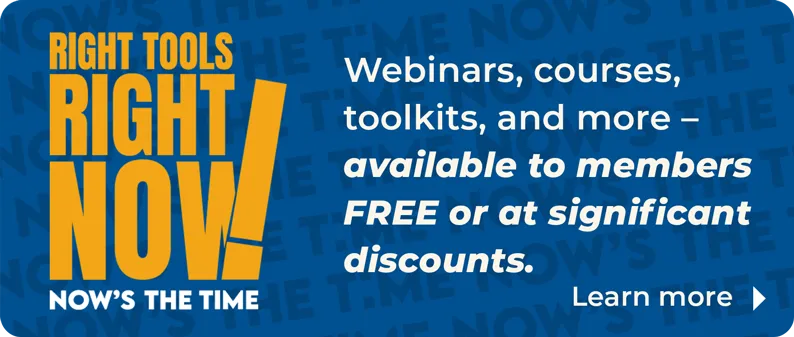1. Offer Micro-volunteering Options
Entice members to start volunteering in small, easy steps with some short-term, one-off, and flexible opportunities. Often called micro-volunteering, these may include a shift behind the registration table at an event, attendance at a forum, or even a few turns at distributing association information via social media channels. Once members get a taste of being part of the team, they’re more likely to sign on to a fuller commitment.
2. Honor, Then Invite
That little stir of envy members feel when watching peers receive applause, public recognition, and awards for their service to the association can be turned into action by having a committee sign-up table at your awards ceremonies and installation parties. Waiting even a day can be too late. Put a committee sign-up form by every chair, and most important, follow up with a phone call.
3. Get Them While They’re Young (or New)
Most new members attending your association’s orientation are motivated and excited to be part of the organization and are especially attracted to the networking aspects of volunteering, so there’s no better time to sign them up to a committee or work group. Yes, chances are high that they may not follow through with the commitment because of challenges they face establishing themselves in the industry. Plus, they may not have enough experience to contribute on higher-level committees, such as strategic planning or finance. But association executives say their enthusiasm, energy, and fresh perspectives often outweigh their shortcomings. Establish a culture of contribution early on, and you may have a volunteer for life.
At every member orientation, include an overview of volunteer opportunities delivered by a passionate board member or your association president live or in a video. Include a simple sign-up card in new-member materials that lists all your association’s volunteer opportunities.
4. Enlist Leadership to Identify & Recruit Others
Perhaps the most tried-and-true way of boosting volunteer ranks is to have association volunteer leaders approach their peers, colleagues, and agents with a personal appeal. After all, it’s their association, and most AEs put leadership recruiting squarely in the members’ hands.
When asked “Why do you think members don’t volunteer?” most AEs responding to RAE’s survey indicated that members who don’t volunteer just are not engaged with the association in any way. For those members who do not read association communications or attend events, the only way to reach them is often through the members they do transactions with or share an office with.
Make it as easy as possible for your leaders and committee chairs to recruit new volunteers. Provide scripted emails and texts for leaders to send, post detailed committee descriptions with estimated commitment hours on your website, have an easy sign-up form, and challenge each leader to bring in at least one new volunteer a year with a prize for the recruiter who brings in the most volunteers.
5. Post the Volunteer Easy Button
Association surveys show that many members don’t volunteer because they don’t know where to start. Calling the association office and asking how to volunteer sounds easy to an AE, but to a member it can be intimidating. Members often think they’re not qualified or that they’re not in the “in crowd” and won’t be welcome. That’s why posting a call for volunteers, with clear instructions, on your website and social media channels, in your newsletters, and in your publications is so important. Do you have an entire webpage devoted to volunteering including opportunities, testimonials, a volunteer job description, and a sign-up form? Do you use taglines on all staff correspondence inviting members to volunteer?
6. Host a Committee Fair
Committee fairs, often held in conjunction with membership lunches or other events, include information tables staffed by members presenting details on what the group is responsible for. Breanna Vanstrom, RCE, CEO of the Boise Regional REALTORS®, says her committee fair yields about 15 new volunteers a year who probably wouldn’t have come forward had the association not been proactive. “Our annual Introduction to Leadership event attracts members who are mostly interested in association leadership but didn’t know where to get started,” she says. “We usually have them volunteer for a committee as a first step and tell them about all of the opportunities we offer.”
Attendees at the Hampton Roads REALTORS® Association’s (Va.) committee fair receive a passport to have stamped at each council or committee, to be entered for prize drawings.
Encouraged by the success of its inaugural event in 2018, HRRA decided to make the fair into an annual event. “We were able to educate members who may not have realized exactly what certain councils or committees actually did, how the members could benefit from engaging with these groups, and that they were able to participate to gain leadership experience and influence the direction of their association,” says the association’s Executive Director, Cathy Crossfield.
7. Target Skilled Members With Custom Opportunities
The more you know about your members, including their past jobs, formal education, and experiences, the better you can target individuals for specific volunteer opportunities. Today’s association management and volunteer software can help you gather and cross reference members’ skills to your volunteer needs. Members with accounting experience are clear candidates for your finance committee, and those with a declared interest in community service are perfect for your outreach committee. Approaching members with volunteer opportunities tailored to their strengths and interests is more likely to be successful.
8. Points & Awards for Volunteer Participation
Your members probably have a few rewards cards in their wallet, so they know how the idea works: Every time members volunteer, attend a meeting or class, or participate in an event, they get points. At the end of the year, award a prize for the member with the greatest number of points, or allow members to use points toward raffle tickets, dues credits, or other incentives.
“I am hearing some good things from the membership about our new Points for Participation program,” says Sue Pyzynski, AE at the Mid-State Association of REALTORS® in Connecticut. A list of points opportunities is on the association’s website, and at the end of the year, points are converted into dollars that can be used to bid on prizes.
Amy DuBose, RCE, AE at the Bryan-College Station Regional Association of REALTORS® in Texas, launched a punch-card rewards program last year. “One punch for every event, class, committee meeting, etc., attended. Eight punches complete the card, and it goes into a quarterly drawing for $100. All cards go in an end-of-the-year drawing for one year’s worth of dues,” she says. The punch card also eliminates the often-daunting task of tracking points. At the REALTORS® Association of Southwestern Illinois, AE Deb Treat Frazier, RCE, offers “RASI bucks” that members can earn for attending events and volunteering. “They can use them for CE courses, events, or at our REALTOR® store,” she says. “We put our current president’s picture on the bucks.”
9. Promote the ROI of Serving
REALTOR® volunteers routinely say that they get more than they give. Use their words in your communications to promote the return on investment of serving on an association committee. Here are just some reasons members say they volunteer: I make more money through the contacts I found volunteering, I can work from inside to enhance my REALTOR® association, I feel good about serving an important cause, I want to give something back to my profession, I want to build my resume with new positions and skills, I enjoy the personal satisfaction of helping others, I’m able to amplify my voice for change in my community, I’ve learned new skills I can apply to my business, and I’ve gotten to know and serve my local community even better.








